
Light Delivery
Jump to:
Options
Lumencor’s primary light delivery options are coupling through liquid light guides (LLG), optical fibers, fiber bundles, or projection optics. Our standard liquid light guide and optical fiber output coupling solutions are designed to meet the requirements of most end-user applications. Moreover, a wide range of light output couplers can be tailored to meet the needs of custom Light Engine and optical scanners.

SOLA Light Engine LLG connection.
LLGs and Fibers Compared
The optical transmission medium of a liquid light guide is continuous. The optical transmission medium of an optical fiber bundle is discontinuous, with interstitial packing volume. Generally, liquid light guides are preferred for wide field illumination derived from LEDs. Optical fibers are preferred for high brightness applications in which high power levels are required over small areas. Typically, such laser applications use our CELESTA and ZIVA Light Engines.

Cross section comparison of Optical Fiber (left) and Liquid Light Guide (right).
General Characteristics of LLGs
Liquid light guides consist of a non-toxic, high refractive index liquid enclosed in a sealed fluoropolymer tube with polished fused silica windows at the ends. Two types of outer sleeve are available – standard PVC (10-10084) or corrugated stainless steel (10-10992). The dimensions of the terminal stainless steel ferrules are the same at both ends of the light guide. A 2m LLG with 3 mm diameter active core is recommended for most widefield fluorescence microscopy applications. Additional OEM options are available upon request.

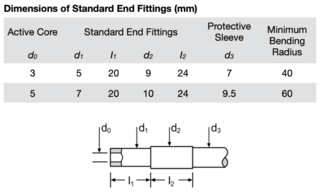
3mm diameter liquid light guide with stainless steel sleeve, 2 meter length (10-10992).
Dimensions of standard end fittings (mm)
Optical Transmission of LLGs
Transmission of the standard 3 mm diameter liquid light guides (10-10084, 10-10992) covers the wavelength range 360–750 nm required for most fluorescence microscopy applications. For applications requiring fluorescence excitation below 360 nm such as fura-2 calcium imaging, a 3 mm diameter liquid light guide with enhanced ultraviolet transmission (10-10448) is available. The numerical aperture (NA) of Lumencor liquid light guides is 0.59.
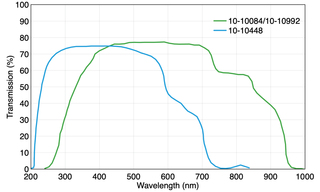
Enhanced UV transmission of LLG (Blue Line) optimized for fura-2 calcium imaging. Green Line, standard LLG transmission.
Care and Handling of LLGs
When used in accordance with our installation and use precautions, liquid light guides typically remain serviceable for at least five years and should not require replacement. Unlike metal halide lamps, solid state Light Engines do not transmit heat to the liquid light guide, and do not generate ultraviolet light output below 340 nm. The most common cause of diminished liquid light guide performance is user-inflicted damage. Customers are advised to observe the installation and use precautions displayed on the liquid light guide shipping pouch. Diminished liquid light guide performance is usually manifested by uniform output power reduction at all wavelengths relative to the benchmark values on the Light Engine certificate of conformance.
Care Instructions
Observe these precautions to ensure optimum LLG performance.
- Do not bend the light guide beyond its specified minimum bending radius (40mm or 1.6 inches). Extreme bending of the light guide may cause permanent deformation, resulting in decreased light transmission.
- Do not reposition the light guide while it is secured to the Light Engine and the microscope. Release the securing set screws, reposition the light guide, then refasten the set screws.
- Do not use outside the specified operating temperature range (-5–35 degrees Celsius).
- When shipping the light guide, detach it from the Light Engine and microscope and coil it loosely in the original shipping pouch. When packing, make sure that the light guide is placed so that it cannot be pinched between solid objects (for example between the lid and the body of a Pelican case).
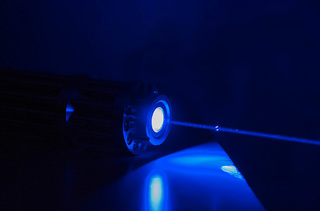
Collimators
Lumencor collimating adapters convert the divergent output of 3 mm LLGs into collimated input for Nikon, Olympus, Zeiss and Leica microscope epilluminators. Light propagation from the collimating adapter to the epilluminator to the objective produces uniform Koehler illumination at the sample plane.

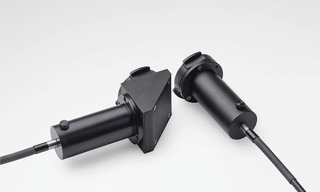
Collimator Orientation Options: Right angle LLG to Scope Collimator (left) and Straight through LLG to Scope Collimator (right).
Customized Light Delivery Solutions
Lumencor Light Engines and scanners are inherently adaptable, scalable and amenable to customization. Light delivery solutions beyond those outlined above can be readily implemented in customized products. We welcome your custom illuminator or scanner requests. Simply use Lumencor's online Quote Request Form.
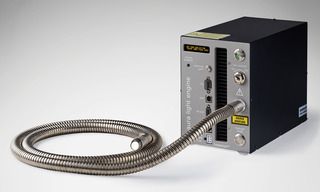
OEM Custom AURA Light Engine with 13mm fiber bundle output.
Critical Epilluminators
Single-molecule localization microscopy requires higher levels of irradiance than can be obtained from Koehler illumination. To facilitate these applications, Lumencor has developed critical epilluminators for use in combination with the CELESTA Light Engine that provide uniform illumination over a smaller field of view but with much higher irradiance than Koehler illumination. Critical epilluminators compatible with all major research microscope brands are available.
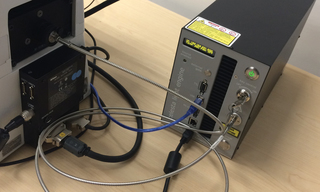
Critical epilluminator installed on a Nikon Ti2 microscope, with SMA-terminated optical fiber connection to CELESTA Light Engine.


